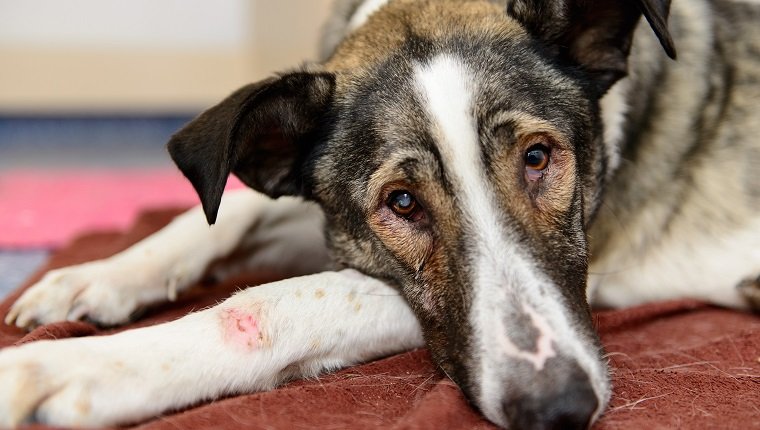Battery Toxicosis
OVERVIEW
Alkaline/Acid-based batteries—ulcers to the gastrointestinal tract from leaking contents, oral injury from chewing on casing and rarely heavy metal toxicity from break down of casing in the GI tract.
Disc/Button/Lithium Ion batteries—rapid necrosis to the esophagus and stomach due to electric current from the battery. Significant necrosis can occur 15 minutes after contact.
SIGNALMENT
Dogs, cats, birds and small mammals. Young animals are more commonly affected.
SIGNS
Historical: finding chewed-up electronic equipment without the battery, a chewed or mangled battery, or battery packaging.
Physical:
Oral ulcerations
Oral injury from chewing on battery casing
Loss of appetite, drooling, regurgitation, vomiting, diarrhea, melena, progressive weakness, dyspnea, coughing, stridor, pleuritis, pyothorax, and pneumo-mediastinum.
DIAGNOSIS
DIFFERENTIAL DIAGNOSIS
History, complete oral exam and full (esophagus and abdominal gastrointestinal tract) survey radiographs of the digestive tract enable diagnosis. Black debris in the oral cavity is evidence of leaked battery contents from a dry cell battery. Distinguish from exposure to other corrosive compounds (cleaning agents, drain cleaners, pool shocking agents, essential oils, and mechanical injury from chewing).
CBC/BIOCHEMISTRY/URINALYSIS
Anemia—secondary to bleeding gastrointestinal ulceration.
Leukocytosis—inflammation and secondary infection.
Elevated total proteins/prerenal azotemia—secondary to dehydration.
Elevated liver enzymes secondary to heavy metal toxicity from break down of casing.
IMAGING
Full survey radiographs—determine if a battery was swallowed, assess location and condition of battery and casing, look for evidence of perforation and/or obstruction.
Endoscopy—pending severity of signs, evaluate extent of damage to the esophagus. May be able to remove the battery or casing. Use caution and do not damage the esophagus.
TREATMENT
Lavage the oral cavity for 10–15 minutes for alkaline batteries; for disc batteries give 10–20 mL of water every 15 minutes until battery is out of the esophagus.
Do NOT induce vomiting as this may expose the esophagus to further injury.
NPO or slurry feeding for 24–48 hours if oral ulcerations are present.
Ulceration may not be visible in the oral cavity until 48 hours post exposure.
Wear gloves when cleaning up any battery debris as leaked acid could cause injury to the hands.
Small, intact dry cell batteries in the stomach should pass within 48 hours. Evaluate all stools and if the battery has not passed the pylorus in 48 hours it should be surgically removed.
Punctured dry cell batteries and disc/button/lithium ion batteries should be immediately removed by endoscopy or surgery.
MEDICATIONS
Analgesics—ulcerations can be very painful.
Dogs—tramadol 2–5 mg/kg PO q6–8h.
Cats—buprenorphine 0.01–0.03 mg/kg buccal, IV or IM.
H2 Blocker—to aid in the healing of gastric ulcerations.
Famotidine 0.5 mg/kg PO or SQ q12h.
Sucralfate 0.25–1 gram PO q8h on an empty stomach.
Antibiotics—to prevent secondary infection when ulcers are present.
Metronidazole 10–30 mg/kg PO q12–24h.
Enrofloxacin: cats, 5 mg/kg PO q24h; dogs, 5–10 mg/kg PO q12h.
CONTRAINDICATIONS
Emetics—emesis should not be performed as it may worsen damage to the esophagus.
Steroids—may reduce risk of esophageal stricture but expected to slow healing time.
NSAIDs—–aid in pain management and swelling reduction but may increase risk of gastric ulceration/perforation.
FOLLOW-UP
PATIENT MONITORING
Consider endoscopy 2 weeks post exposure to assess esophagus.
POSSIBLE COMPLICATIONS
Esophageal perforation, esophageal stricture, gastrointestinal obstruction, heavy metal toxicity.
EXPECTED COURSE AND PROGNOSIS
Non- ruptured dry cell battery: excellent, most pets pass on own within 48 hours.
Ruptured dry cell battery: guarded, pending location of corrosive exposure and amount of time before removal. Esophageal injury worsens prognosis.
Disc/button/lithium ion battery: guarded, rapid removal is needed. Significant injury, including esophageal or gastric perforation, can occur within 15 minutes of the ingestion.
MISCELLANEOUS
ASSOCIATED CONDITIONS
Heavy metal toxicity, esophagitis, esophageal stricture, esophageal perforation, gastrointestinal obstruction.
Visit your veterinarian as early recognition, diagnosis, and treatment are essential.
To learn more about your pet’s health and diet click here.

